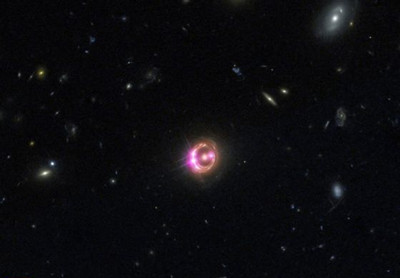Two remarkable things about a giant black hole called RX J1131 at the center of a galaxy some 6 billion light years away.
在銀河系中心距離我們大約6億光年有一個被命名為RXJ1131的巨型黑洞,對于它有兩件值得注意的事情。
One:it's the farthest black hole to have its spin measured.
首先是根據它的旋轉速度測量,這是目前所發(fā)現最遙遠的一個黑洞。
Two:it's spinning at half the speed of light.
其次是其轉速接近光速的一半。
That's according to a report in the journal Nature.
這是根據最近在《自然》雜志上刊登的一篇研究報道得出的結論。

Astronomers have wondered, do large black holes grow gradually via steady intake of material; or quickly, for example, in a merger with another black hole during a galactic collision.
天文學家們很好奇,大型黑洞是依靠穩(wěn)定的吞噬物質使自己逐漸增大還是快速成長,比如在銀河系大爆炸的時候融合了另外一個黑洞快速成長。
Spin offers clues.
這個黑洞的急速旋轉的模式可以為我們提供一些線索。
If the merger idea is correct, lots of new material flowing in a single direction feeds a black hole, driving the spin faster one way.
如果融合理論是正確的,來自同一方向的大量新物質流入可以促使黑洞成長,從而使得按照一個方向高速旋轉。
But a black hole that ate small meals from different directions would receive tiny pushes that cancel each other, and leave the black hole spinning slowly.
但吸收不同方向小物質的黑洞或許會受到微小的推力從而互相抵消二者間的吸引力,致使黑洞轉速下降。
The half-the-speed-of-light-fantastic being tripped by this newly analyzed black hole thus suggests it grew by digesting another black hole in a galaxy merger.
接近一半光速的不可思議這一最新分析的黑洞向我們揭示它是銀河系融合事件中通過消化另一個黑洞而不斷膨脹擴大。
Our own Milky Way's black hole could be in for a similar fate when we collide with our neighbor, the Andromeda Galaxy.
當我們的銀河系黑洞和鄰居仙女座星系相碰撞時,可能會發(fā)生同樣的命運。
Relax, it's not for another four billion years.
別太緊張,要等40億年之后才有可能上演。












